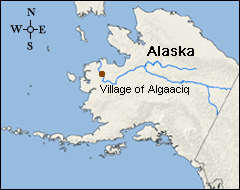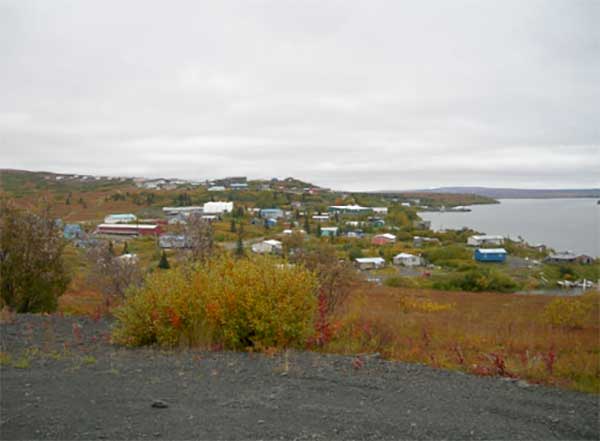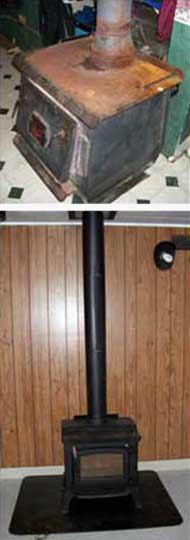Tribal Profiles - Alaska Region
- Tribal Profiles
- Alaska
- Algaaciq Native Village
- ANTHC Assessing Health Impacts and Documenting Observed Changes
- ANTHC Portable Alternative Sanitation System
- Central Council of the Tlingit & Haida Indian Tribes of Alaska
- Norton Bay Inter-Tribal Watershed Council
- Reindeer Herders Association
- Yupik Changes & Observations
- Tribal Profiles
- Alaska
- Algaaciq Native Village
- ANTHC Assessing Health Impacts and Documenting Observed Changes
- ANTHC Portable Alternative Sanitation System
- Central Council of the Tlingit & Haida Indian Tribes of Alaska
- Norton Bay Inter-Tribal Watershed Council
- Reindeer Herders Association
- Yupik Changes & Observations

Algaaciq Native Village
Click HERE for PDF version.

Algaaciq Native Village (also known as St. Mary’s) is a predominantly Yupik village of approximately 500 people. The village lies near the confluence of the Andreafsky and Yukon Rivers, upstream from the delta into the Bering Sea in southwest Alaska. (State of Alaska).
Algaaciq residents rely heavily on harvested resources from the land and river. Salmon, moose, bear and waterfowl are gathered throughout the year and are supplemented by cash incomes earned through commercial fishing, trapping and/or other public sector labor opportunities. According to the State of Alaska’s community profile, Algaaciq’s 2010 average per capita income was $15,688 and the median household income was $38,000. The unemployment rate was 25.7%. (State of Alaska). Hence, harvesting from the land is a critical means of survival in this area of the state.
Impacts of a Changing Climate
In recent years, the area has been experiencing a warmer climate that is believed to be a result of climate change. This has had an impact on the people and their lifestyle, forcing residents to adapt to recent conditions. Changes include permafrost thaw that is causing infrastructure damage, and different weather patterns that continually impact the growing season, affecting berry production and harvests. Furthermore, new insects, rodents, birds and mammal species not usually seen in the area have been appearing. The migration habits of traditional terrestrial species including moose and caribou are beginning to change, and residents have noticed biological changes in traditionally harvested species, such as ‘pus sacks’ in salmon. (NAFWS, 2011)

Charles Prince, the Environmental Program Coordinator for St. Mary’s Algaaciq Tribal Government, has observed additional changes in his 35 years of life; he has noticed that, “every year is different, every winter is not the same as the previous winter.” Typically this area of Alaska is characterized by long and cold winters, which is why residents were baffled when it rained in St. Mary’s during the middle of the winter season. In addition, a deep cold spell is expected during the winter, typically in February, but this year the residents of St. Mary’s experienced it in December. The residents use the frozen rivers as transportation routes during the winter, so changes to the timing and length of cold periods impact their activities, including hunting.
In addition to the climatic changes, Charles has also noticed that water levels have been lower than normal in the last few years; this has contributed to difficulties for hunting access to certain creeks and channels. Landscape alterations due to climate change drive citizens of rural Alaska to adapt to the unusual conditions; in this case, hunters who were able to harvest a moose had to expend more energy to pack a moose farther than normal. “You just adapt to the changes, you have no choice (but) to adapt to whatever situation comes up,” explained Charles.

Mitigation Efforts
In addition to adapting to the changing climate, the Algaaciq Tribal Government has been moving forward in mitigation efforts with the help of the Alaska Native Tribal Health Consortium’s (ANTHC) Community Environmental Demonstration Grants Program. The U.S. Environmental Protection Agency (EPA) provides funding to ANTHC who in turn works with Zender Environmental to help improve health and the environment in rural Alaska by providing grants that range between $5,000 and $30,000 per year. ANTHC has awarded over $400,000 for a variety of projects throughout the state of Alaska since 2009. (ANTHC website)
In an attempt to increase energy efficiency in homes in Algaaciq Native Village, a 2010 grant helped the tribal government replace 11 old, non-compliant wood stoves with EPA-approved wood stoves. The new wood stoves improved indoor and outdoor air quality, improved the health of the homeowners, and are cleaner and more efficient in terms of the amount of wood burned. In addition, this project reduced the fire risk associated with older chimneystacks and the project provided jobs for local residents. (Algaaciq Tribal Government brochure, 2010)
The project had its fair share of challenges, and thus lessons learned. In purchasing the wood stoves, Algaaciq Tribal Government learned that, ‘what you see is not always what you get.’ The advertised dimensions of the woodstoves were presented to the homeowners prior to installation; however, once the stoves arrived in St. Mary’s, it was clear that they were smaller than advertised. In addition to the dimension predicament, the tribal government realized that the timing of the installation of stoves was a key factor in finding a qualified workforce. Hunting, fishing and construction season proved to be an incompatible time for many residents. (Algaaciq Tribal Government brochure, 2010; Charles Prince interview, 2012)
Despite the challenges, the demo project provided important benefits to not only those that acquired new wood stoves, but also to all other residents of the village. Increased air quality has provided invaluable health advantages, and greater efficiency has increased environmental benefits for all.
Resources and References
In addition to adapting to the changing climate, the Algaaciq Tribal Government has been moving forward in mitigation efforts with Alaska Native Tribal Health Consortium website: http://www.anthc.org/chs/ces/hve/community-environmental-demonstration-grants.cfm, visited on June 5, 2012.
Algaaciq Tribal Government: Woodstove Change-out Project brochure (2010), accessed from the Alaska Native Tribal Health Consortium’s website at: www.anthc.org/chs/ces/hve/community-environmental-demonstration-grants.cfm, visited on May 4, 2012.
Native American Fish & Wildlife Society. Subsistence Lifestyle Changing Rapidly at Native Village of Algaaciq. Article by Karen Lynch. From the Eagle’s Nest. Late Summer 2011. www.nafws.org/images/stories/newsletters/201108_summer.pdf
Prince, Charles, Environmental Program Coordinator under the EPA/IGAP Department of the Algaaciq Native Village. Interview on April 16, 2012.
State of Alaska, Alaska Community Database Community Information Summaries (CIS) – Saint Mary’s. Website: www.commerce.state.ak.us/dca/commdb/CIS.cfm?Comm_Boro_name=Saint%20Mary%27s, visited on August 30, 2012.
Contact Information:
Charles Prince
EPA/IGAP Department
Algaaciq Native Village
Phone: 907-438-2935
Email: algaaciq_epa@yahoo.com
Photos in this profile are courtesy of the Algaaciq Native Village EPA/IGAP Department.
This profile was developed by Larissa Sommer, Institute for Tribal Environmental Professionals, Northern Arizona University, with support from the U.S. Environmental Protection Agency.
The profile is available on the Tribal Wellbeing for Seven Generations Program website: https://itep.nau.edu/twsgp/tribes/. The tribal profiles featured on the website are intended to be a pathway to increasing knowledge among tribal and non-tribal organizations interested in learning about climate change mitigation and adaptation efforts.
CONNECT WITH US
Nikki Cooley
Co-Director
Nikki.Cooley@nau.edu
Karen Cozzetto
Manager
Karen.Cozzetto@nau.edu
Your tax deductible donation supports ITEP’s programming efforts.
Please contact us if you would like to contribute to our endowment or for any additional information regarding donations.

